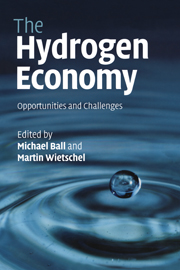Book contents
- Frontmatter
- Contents
- List of main contributors
- Preface
- Acknowledgements
- List of abbreviations
- 1 Scope of the book
- 2 Why hydrogen?
- 3 Non-renewable energy resources: fossil fuels – supply and future availability
- 4 Non-renewable energy resources: nuclear fuels
- 5 Assessment of the potentials for renewable energy sources
- 6 Carbon capture and storage
- 7 Energy-chain analysis of hydrogen and its competing alternative fuels for transport
- 8 Hydrogen today
- 9 Fundamental properties of hydrogen
- 10 Hydrogen production
- 11 Hydrogen storage
- 12 Hydrogen distribution
- 13 Key role of fuel cells
- 14 Hydrogen-infrastructure build-up in Europe
- 15 Building a hydrogen infrastructure in the USA
- 16 Hydrogen and the electricity sector
- 17 Hydrogen corridors
- 18 Macroeconomic impacts of hydrogen
- 19 Sustainable transport visions: the role of hydrogen and fuel-cell vehicle technologies
- 20 Energy-efficient solutions needed – paving the way for hydrogen
- 21 The future of hydrogen – opportunities and challenges
- Further reading
- Index
- References
6 - Carbon capture and storage
Published online by Cambridge University Press: 22 January 2010
- Frontmatter
- Contents
- List of main contributors
- Preface
- Acknowledgements
- List of abbreviations
- 1 Scope of the book
- 2 Why hydrogen?
- 3 Non-renewable energy resources: fossil fuels – supply and future availability
- 4 Non-renewable energy resources: nuclear fuels
- 5 Assessment of the potentials for renewable energy sources
- 6 Carbon capture and storage
- 7 Energy-chain analysis of hydrogen and its competing alternative fuels for transport
- 8 Hydrogen today
- 9 Fundamental properties of hydrogen
- 10 Hydrogen production
- 11 Hydrogen storage
- 12 Hydrogen distribution
- 13 Key role of fuel cells
- 14 Hydrogen-infrastructure build-up in Europe
- 15 Building a hydrogen infrastructure in the USA
- 16 Hydrogen and the electricity sector
- 17 Hydrogen corridors
- 18 Macroeconomic impacts of hydrogen
- 19 Sustainable transport visions: the role of hydrogen and fuel-cell vehicle technologies
- 20 Energy-efficient solutions needed – paving the way for hydrogen
- 21 The future of hydrogen – opportunities and challenges
- Further reading
- Index
- References
Summary
This chapter describes the option of energy conversion of carbon-containing fuels with the capture and storage of the associated CO2. The main capture technologies in the field of hydrogen production are compared with capture technologies for electricity generation. Following the process chain of carbon capture and storage (CCS), transport and storage options for CO2 are discussed. Further societal issues, such as legal and regulatory aspects, as well as public perception are examined.
Why carbon capture and storage?
The world energy supply is still strongly dependent on fossil fuels. According to the IEA (2006), in 2004 some 80% of the world total primary energy supply originated from fossil fuels. As described in Section 2.1.2, the use of fossil fuels and the associated greenhouse-gas emissions are the major source for human-induced climate change; nevertheless, there is a good probability that fossil fuels will also play an important role for energy supply in the coming decades. This holds true not only for the conventional applications, such as electricity, but possibly also for the generation of hydrogen. Reasons for the continued use of fossil fuels are, amongst others, the favourable economics and the physical properties, such as high energy density for use in the transport sector.
Increasing energy efficiency and energy production from renewable sources have the potential to reduce GHG emissions in the long term.
- Type
- Chapter
- Information
- The Hydrogen EconomyOpportunities and Challenges, pp. 168 - 198Publisher: Cambridge University PressPrint publication year: 2009
References
- 7
- Cited by



